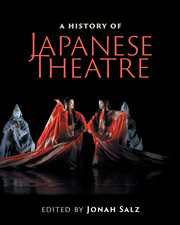Book contents
- Frontmatter
- Contents
- List of figures
- List of tables
- Contributors
- Contributors’ biographies
- Foreword
- Acknowledgments
- Note on Japanese terms
- List of abbreviations
- Timeline
- Editor's introduction
- I Traditional theatres
- Preface to Part I Japanese civilization arises
- II Modern theatres
- Preface to Part II
- III Arcs and patterns
- 12 Premodern playwriting practices
- 13 Traditional meta-patterns
- 14 Modern plays as literature
- 15 Modern meta-patterns
- Interlude Dōjōji: The lady and the bell
- IV Theatre architecture
- Preface to Part IV Evolution of Japanese theatre architecture
- V Theatre criticism
- VI Intercultural influences
- Epilogue: Frozen words and mythology
- Further reading
- Index
12 - Premodern playwriting practices
from III - Arcs and patterns
Published online by Cambridge University Press: 05 July 2016
- Frontmatter
- Contents
- List of figures
- List of tables
- Contributors
- Contributors’ biographies
- Foreword
- Acknowledgments
- Note on Japanese terms
- List of abbreviations
- Timeline
- Editor's introduction
- I Traditional theatres
- Preface to Part I Japanese civilization arises
- II Modern theatres
- Preface to Part II
- III Arcs and patterns
- 12 Premodern playwriting practices
- 13 Traditional meta-patterns
- 14 Modern plays as literature
- 15 Modern meta-patterns
- Interlude Dōjōji: The lady and the bell
- IV Theatre architecture
- Preface to Part IV Evolution of Japanese theatre architecture
- V Theatre criticism
- VI Intercultural influences
- Epilogue: Frozen words and mythology
- Further reading
- Index
Summary
Plays are literary servants to non-literary masters
In Japan's premodern era (1300–1868) written texts were produced to serve specific theatrical events – multimedia, multi-participant, collaborative ventures. The authority and autonomy of play texts as literary works were immaterial. What mattered were effective performances. Some theatrical texts later acquired the status of recognized, stand-alone literary products, but neither this status nor artistic quality indicate the plays’ intrinsic worth as facilitators of performance. Authors were heavily constrained by, dependent on, and subservient to conditions, requirements, and priorities that were decidedly non-literary, and often even non-verbal. Play texts in premodern Japan can be understood as literary servants used and abused by non-literary masters, including: formal codes and structural systems of performance; skills of the lead performer(s) and hierarchical requirements of the performance company; spectators, ranging from aristocratic warlord patrons to admission-paying commoners.
Service to conventions of music, dance, and spectacle
Non-literary performance systems in traditional Japanese theatre center on dance and music. Noh and bunraku (ningyō jōruri) are musical drama, as are most kabuki plays. When we consider opera, the West's great musical dramatic form, libretti for even the finest works are third-rate literature, never included in literary anthologies. The libretti are masterpieces nevertheless – brilliantly fulfilling their supporting roles. Japanese texts play similar roles. Zeami, the greatest dramatist of the noh theatre, was the first Japanese writer to explain the correct process for playwriting. In Sandō (The three elements in composing a play) he wrote:
There are three elements required for the composition of a noh play – the seed (literary sources), the construction, and the composition. The seed should be appropriate for theatrical expression and especially effective in terms of the Two Arts of dance and chant. If the subject concerns a character who cannot be manifested using these Two Arts, then even if the character to be portrayed is a famous person in the past or a person of prodigious gifts, no theatrical effect appropriate to the nō is possible.
Zeami thus defines a proper subject exclusively as that which can be expressed in music and dance. “Creating a character whose very essence is involved in the art of song and dance can be termed choosing the proper seed (tane, 種).”
- Type
- Chapter
- Information
- A History of Japanese Theatre , pp. 366 - 375Publisher: Cambridge University PressPrint publication year: 2016



